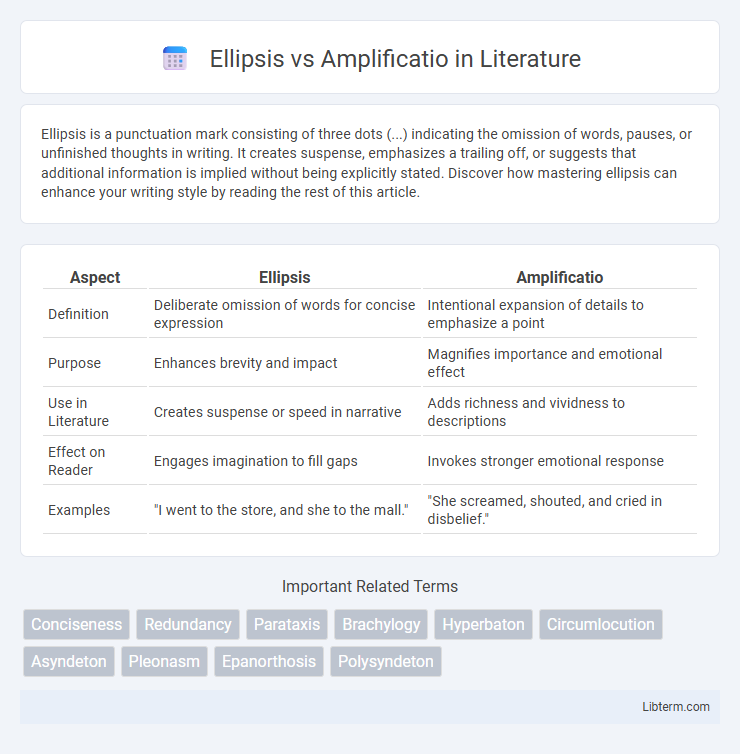Ellipsis is a punctuation mark consisting of three dots (...) indicating the omission of words, pauses, or unfinished thoughts in writing. It creates suspense, emphasizes a trailing off, or suggests that additional information is implied without being explicitly stated. Discover how mastering ellipsis can enhance your writing style by reading the rest of this article.
Table of Comparison
| Aspect | Ellipsis | Amplificatio |
|---|---|---|
| Definition | Deliberate omission of words for concise expression | Intentional expansion of details to emphasize a point |
| Purpose | Enhances brevity and impact | Magnifies importance and emotional effect |
| Use in Literature | Creates suspense or speed in narrative | Adds richness and vividness to descriptions |
| Effect on Reader | Engages imagination to fill gaps | Invokes stronger emotional response |
| Examples | "I went to the store, and she to the mall." | "She screamed, shouted, and cried in disbelief." |
Understanding Ellipsis: Definition and Functions
Ellipsis is a rhetorical device involving the deliberate omission of one or more words that are implied by the context, enhancing conciseness and encouraging reader inference. It functions to streamline communication by removing redundant elements, thereby intensifying the impact of the remaining words and fostering a more engaging narrative. Unlike amplificatio, which expands on ideas through elaboration and detail, ellipsis emphasizes brevity and the power of suggestion through what is left unsaid.
What is Amplificatio? An Overview
Amplificatio is a rhetorical device used to expand on an idea by adding more detail, emphasis, or repetition to enhance the argument or description. It serves to amplify the significance or emotional impact of the message, often by elaborating on a point to make it more persuasive or memorable. Unlike ellipsis, which involves the omission of words for brevity, amplificatio intentionally lengthens the expression for clarity and effect.
Historical Background: Ellipsis and Amplificatio in Rhetoric
Ellipsis and Amplificatio trace their roots to classical rhetoric, with Ellipsis emerging from ancient Greek and Roman traditions as a concise tool to omit words while preserving meaning, enhancing stylistic clarity and impact. Amplificatio, also grounded in classical rhetoric, was developed by Roman orators like Cicero and Quintilian to elaborate and intensify arguments, enriching speeches by expanding ideas for emotional and logical effect. These figures codified Ellipsis and Amplificatio as fundamental devices to balance brevity and elaboration in persuasive communication.
Structural Differences: Ellipsis vs Amplificatio
Ellipsis involves the deliberate omission of one or more words in a sentence while retaining the overall meaning, creating a concise and impactful expression. Amplificatio, on the other hand, expands a statement by adding detailed information, emphasis, or repetition to elaborate on the original idea. Structurally, ellipsis reduces elements for brevity and implied understanding, whereas amplificatio increases the content to enhance clarity and persuasive effect.
Purpose and Effect: Conciseness vs Emphasis
Ellipsis creates conciseness by omitting unnecessary words, allowing readers to fill in gaps and maintain narrative brevity. Amplificatio focuses on emphasis by elaborating details or repeating ideas to highlight significance and evoke stronger emotional response. The purposeful use of ellipsis promotes efficiency and subtlety, while amplificatio intensifies impact and clarity through expansion.
Common Examples: Ellipsis in Literature
Ellipsis in literature often appears in dialogues where omitted words are understood from context, such as Shakespeare's "To be, or not to be" omitting "that is the question." Amplificatio, by contrast, involves expanding a statement to emphasize or clarify, commonly used in rhetorical speeches. Ellipsis creates concise, impactful expressions by leaving gaps, while amplificatio enriches the narrative through detailed elaboration.
Illustrating Amplificatio: Usage in Classic Texts
Amplificatio is a rhetorical device used in classic texts to expand on ideas by adding more detail, emphasis, or examples, enhancing the persuasive effect. For instance, Cicero often employed amplificatio in his speeches to elaborate on arguments, making them more vivid and compelling for his audience. This technique contrasts with ellipsis, which omits words for brevity and impact, while amplificatio enriches content to deepen understanding.
Applications in Modern Writing: Ellipsis and Amplificatio
Ellipsis streamlines modern writing by omitting unnecessary words to enhance clarity and emotional impact, making narratives and dialogues more engaging and efficient. Amplificatio, on the other hand, enriches texts by elaborating on ideas or emotions, providing depth and persuasive power in speeches, essays, and advertising. Both devices are vital in digital content creation, marketing copy, and literary works for balancing brevity and expressiveness.
Best Practices: When to Use Ellipsis vs Amplificatio
Ellipsis is best used to create a concise, impactful message by deliberately omitting unnecessary words, enhancing clarity and focus. Amplificatio works well when emphasizing a point or elaborating on details to increase emotional intensity or persuasion. Choose ellipsis for brevity and subtlety, and amplificatio for emphasis and vividness, tailoring the choice to your audience's engagement level and the communication goal.
Conclusion: Enhancing Writing Through Rhetorical Devices
Ellipsis and amplificatio serve distinct rhetorical purposes that enhance writing by controlling information flow and emotional impact. Ellipsis omits non-essential words, creating conciseness and inviting reader inference, while amplificatio expands on ideas to emphasize significance and persuade effectively. Mastering these devices sharpens writing clarity and depth, making arguments more compelling and engaging.
Ellipsis Infographic

 libterm.com
libterm.com